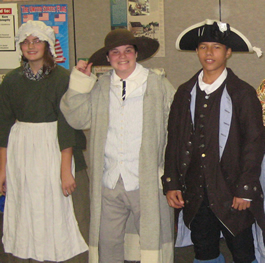
|

Essential Questions:
How is history interpreted to relate the past to the present?
How do the concepts of family, education, leisure, government, economics, religion, and communication define a culture?
How are investigative tools used by historians to study and interpret history?
How is history linked to economics and other social sciences?
How did education and social issues influence various colonies?
What can I learn from the past?
How am I connected to people and events from the past?
What causes change, and what stays the same?
What patterns develop in the course of history?
How are cause and effect shown throughout history?
How do historical and social events shape the future?
History Standards: 8.1 A,B,D 8.2.3 A,B,C,D 8.2.6 A,B,C,D 8.3.3 A 8.3.6 A,B,D
Reading Standards: 1.1.5.A,G 1.2.A 1.3.A,F 1.6.A,B,D,E
“It’s always a lot of fun when you come to our school and give us a break from the normal everyday stuff that we have to learn. I always learn a lot from you. I love that you have props to go with what you’re teaching. It always makes learning so much more interesting if we can actually see and feel the things that we are learning about.”
Rachel D.


